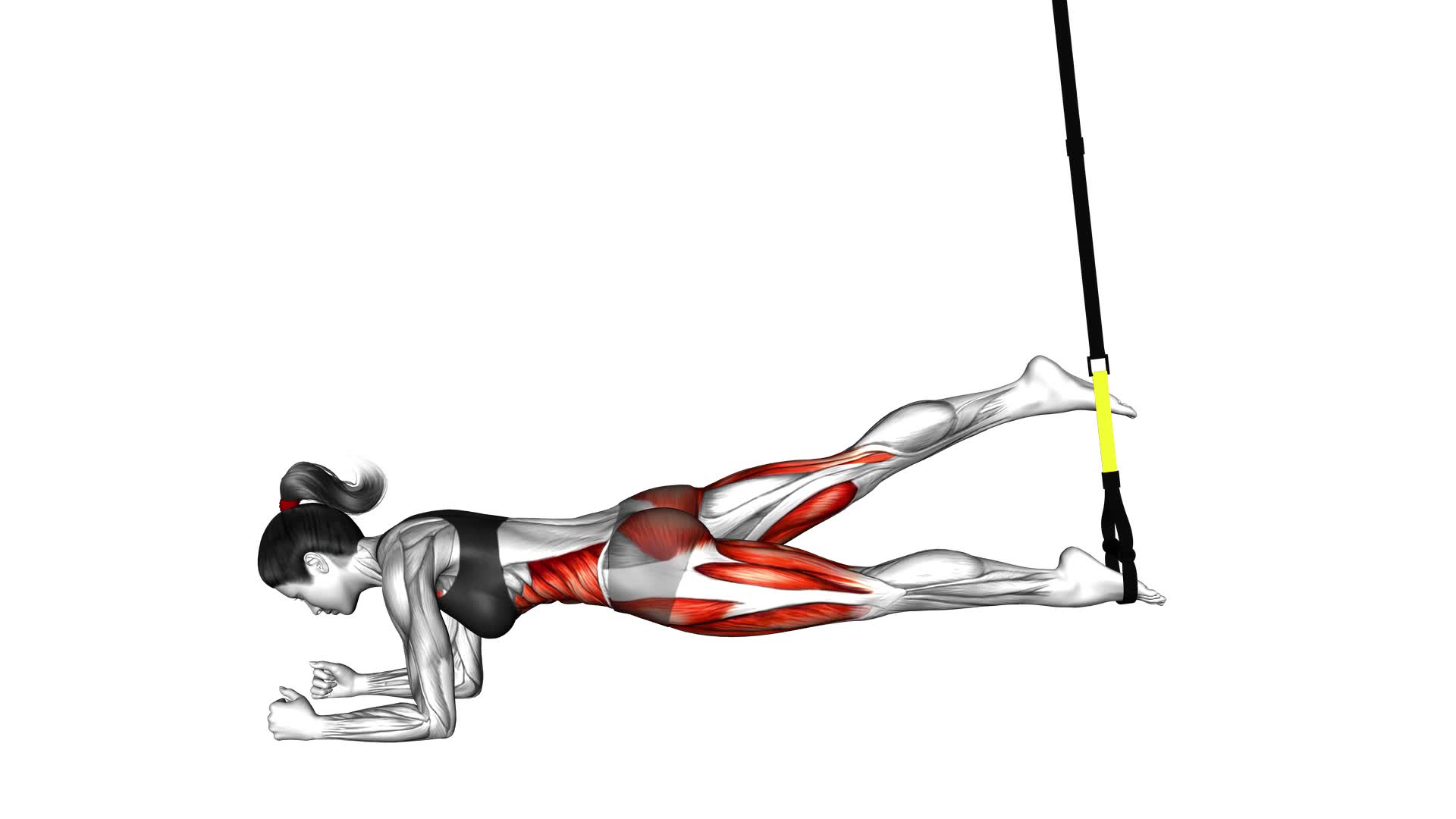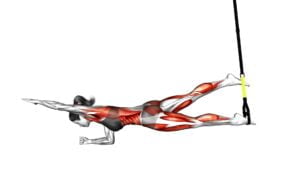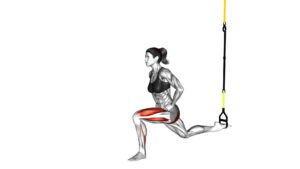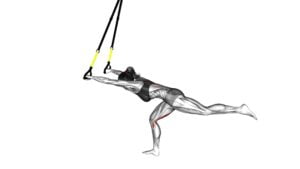Suspender Single Leg Plank (female) – Video Exercise Guide & Tips

Get ready to strengthen your core and challenge your balance with the Suspender Single Leg Plank. In this video exercise guide, we'll show you the proper form and technique for this effective exercise. Whether you're a beginner or advanced, we've got variations and modifications to suit your fitness level.
Watch This Exercise Video
Plus, we'll share common mistakes to avoid and tips for progression and challenge.
Let's dive in and get those abs fired up!
Key Takeaways
- The Suspender Single Leg Plank is a beneficial exercise for improving core strength, stability, posture, and balance.
- Proper form and technique are crucial to avoid injuries such as lower back strain or shoulder pain.
- There are various variations and modifications of the Suspender Single Leg Plank to challenge core strength and stability.
- Progression and challenge can be achieved by increasing the duration of the exercise, lifting the leg higher, or performing it on an unstable surface.
Benefits of the Suspender Single Leg Plank
You can experience numerous benefits by incorporating the Suspender Single Leg Plank into your workout routine.
This exercise is highly effective in improving core strength and increasing stability.
The Suspender Single Leg Plank engages your core muscles, including the rectus abdominis, obliques, and transverse abdominis. These muscles play a crucial role in stabilizing your spine and maintaining proper posture. As you perform the exercise, you'll feel your core muscles working hard to keep your body in a straight line. Over time, this will lead to improved core strength, making everyday activities easier and reducing the risk of lower back pain.
Additionally, the Suspender Single Leg Plank challenges your balance and stability. By lifting one leg off the ground, you force your core muscles to work even harder to maintain stability. This not only strengthens your core but also improves your overall balance, which is essential for preventing falls and injuries.
Incorporating the Suspender Single Leg Plank into your workout routine will provide you with the benefits of improved core strength and increased stability.
Proper Form and Technique
To maintain proper form and technique during the Suspender Single Leg Plank, focus on engaging your core muscles and keeping your body in a straight line. This exercise may seem challenging at first, but with the right technique, you can maximize its benefits while minimizing the risk of common injuries. Here are some key points to keep in mind:
- Engage your core: Make sure to activate your abdominal muscles throughout the exercise. This won't only help stabilize your body but also prevent excessive strain on your lower back.
- Maintain a straight line: Your body should form a straight line from head to toe. Avoid sagging hips or raising your hips too high. This will ensure that you're effectively engaging your core and targeting the right muscles.
- Common misconceptions: One common misconception is that you need to hold your breath during the exercise. Remember to breathe continuously and rhythmically to maintain a steady flow of oxygen to your muscles.
- Common injuries: Improper form can lead to injuries such as lower back strain or shoulder pain. Take your time to master the correct technique before progressing to more advanced variations.
Variations and Modifications
To explore variations and modifications of the Suspender Single Leg Plank, consider adding different degrees of difficulty to challenge your core strength and stability.
One advanced modification you can try is the Suspender Single Leg Plank with Knee Tuck. In this variation, instead of keeping your leg extended, you bring your knee towards your chest and then extend it back out. This adds an extra challenge to your core muscles and requires more control and balance.
Another advanced modification is the Suspender Single Leg Plank with Hip Abduction. In this variation, instead of keeping your leg extended, you lift it out to the side, engaging your outer hip muscles. This not only targets your core but also works on your hip strength and stability.
If you're looking for alternative variations, you can try the Suspender Single Arm Plank. Instead of using both arms, you can challenge yourself by using only one arm to support your body weight. This puts more emphasis on your core and requires greater stability.
Another alternative variation is the Suspender Spider Plank. In this variation, you bring your knee towards your elbow, alternating sides. This adds a dynamic element to the exercise and targets your obliques as well.
Common Mistakes to Avoid
One common mistake to avoid when performing the Suspender Single Leg Plank is allowing your hips to sag. This can happen when you lack core strength or lose focus on maintaining proper form.
To prevent this mistake and improve your performance, here are some tips:
- Engage your core: Keep your abdominal muscles tight throughout the exercise. This will help stabilize your body and prevent your hips from sagging.
- Maintain a straight line: Imagine your body as a plank, with your head, shoulders, hips, and legs forming a straight line. Avoid arching or rounding your back, as this can put unnecessary pressure on your spine.
- Squeeze your glutes: By activating your glute muscles, you can further stabilize your hips and maintain proper alignment.
- Avoid lifting the leg too high: While performing the single leg variation, be mindful of your leg height. Lifting it too high can cause your hips to rotate or sag. Aim for a position where your leg is parallel to the ground.
- Breathe and focus: Don't forget to breathe steadily throughout the exercise and maintain your focus on form and stability.
Tips for Progression and Challenge
To progress and challenge yourself in the Suspender Single Leg Plank, focus on increasing the duration of the exercise and adding variations to further engage your muscles. Here are some progression tips and challenging exercises to help you take your workout to the next level.
First, aim to hold the Suspender Single Leg Plank for longer periods of time. Start by holding the position for 30 seconds, then gradually increase the duration to 60 seconds or more. This won't only build endurance but also strengthen your core muscles.
Next, you can add variations to make the exercise more challenging. One option is to lift your leg higher while maintaining the plank position. This increases the load on your core and requires greater stability. Another variation is to perform the exercise on an unstable surface, such as a Bosu ball or a foam pad. This will challenge your balance and engage more muscle fibers.
Additionally, you can incorporate knee tucks into the Suspender Single Leg Plank. Start in the plank position and then bring one knee towards your chest, alternating between legs. This adds an element of dynamic movement and increases the intensity of the exercise.
Remember to listen to your body and progress at a pace that's comfortable for you. By gradually increasing the duration and adding variations, you'll continue to challenge your muscles and improve your overall strength and stability.
Frequently Asked Questions
How Long Should I Hold the Suspender Single Leg Plank to See Results?
To see results from the suspender single leg plank, focus on holding the position for as long as you can maintain proper form. This exercise targets your core, shoulders, and legs, helping to improve stability and strength.
By challenging your muscles with variations of the suspender single leg plank, such as lifting the leg or adding a twist, you can further enhance the benefits.
Consistency and gradually increasing your hold time will lead to visible results over time.
Can This Exercise Help Me Lose Belly Fat?
Doing the Suspender Single Leg Plank can definitely contribute to weight loss and help you lose belly fat. This exercise targets your core muscles, which can help strengthen and tone your abs.
However, it's important to remember that spot reduction isn't possible, and overall weight loss is achieved through a combination of regular exercise and a healthy diet.
Is the Suspender Single Leg Plank Suitable for Beginners?
Yes, the suspender single leg plank can be modified for beginners. You can start by doing the exercise with both legs on the ground instead of lifting one leg. This will help you build strength and stability in your core.
As you get more comfortable, you can progress to lifting one leg at a time. This exercise is great for strengthening your core muscles and improving your overall stability.
Can I Do This Exercise if I Have Lower Back Pain?
If you have lower back pain, it's important to be cautious when doing the suspender single leg plank. This exercise puts pressure on your lower back, which may aggravate your pain.
Instead, consider alternative exercises that target your core without straining your back, such as modified planks or bird dogs.
However, if your lower back pain is manageable, the suspender single leg plank can be beneficial for strengthening your core muscles and improving stability.
How Many Sets and Reps Should I Do for the Suspender Single Leg Plank?
To get the best results from the suspender single leg plank, it's important to focus on sets and reps. Start with 2-3 sets of 10-12 reps per leg.
As you get stronger, you can increase the number of sets or reps. Consistency is key, so aim to do this exercise 2-3 times a week.
Conclusion
The suspender single leg plank is a challenging exercise that targets the core and helps improve stability and balance.
By maintaining proper form and technique, you can maximize the benefits and avoid common mistakes.
With variations and modifications, you can tailor the exercise to your fitness level.
Remember to progress gradually and challenge yourself for continued improvement.
Incorporating the suspender single leg plank into your workout routine can contribute to a stronger and more functional core.

Author
Years ago, the spark of my life’s passion ignited in my mind the moment I stepped into the local gym for the first time. The inaugural bead of perspiration, the initial endeavor, the very first surge of endorphins, and a sense of pride that washed over me post-workout marked the beginning of my deep-seated interest in strength sports, fitness, and sports nutrition. This very curiosity blossomed rapidly into a profound fascination, propelling me to earn a Master’s degree in Physical Education from the Academy of Physical Education in Krakow, followed by a Sports Manager diploma from the Jagiellonian University. My journey of growth led me to gain more specialized qualifications, such as being a certified personal trainer with a focus on sports dietetics, a lifeguard, and an instructor for wellness and corrective gymnastics. Theoretical knowledge paired seamlessly with practical experience, reinforcing my belief that the transformation of individuals under my guidance was also a reflection of my personal growth. This belief holds true even today. Each day, I strive to push the boundaries and explore new realms. These realms gently elevate me to greater heights. The unique combination of passion for my field and the continuous quest for growth fuels my drive to break new ground.







